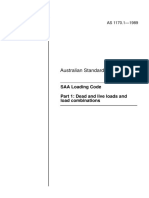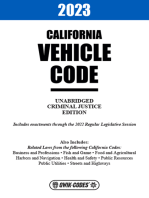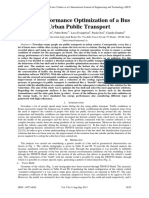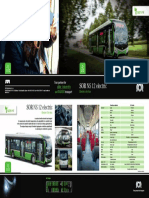Adr 2-01 Am2 Es
Adr 2-01 Am2 Es
Uploaded by
FWEFWEFWCopyright:
Available Formats
Adr 2-01 Am2 Es
Adr 2-01 Am2 Es
Uploaded by
FWEFWEFWOriginal Title
Copyright
Available Formats
Share this document
Did you find this document useful?
Is this content inappropriate?
Copyright:
Available Formats
Adr 2-01 Am2 Es
Adr 2-01 Am2 Es
Uploaded by
FWEFWEFWCopyright:
Available Formats
Vehicle Standard (Australian Design Rule 2/01 –
Side Door Latches and Hinges) 2006
Amendment 2
Made under section 7 of the Motor Vehicle Standards Act 1989
Explanatory Statement
Issued by the authority of the Minister for Urban Infrastructure
September 2016
Authorised Version Explanatory Statement registered 20/09/2016 to F2016L01459
2
Explanatory Statement
Vehicle Standard (Australian Design Rule 2/01) 2006 Amendment 2
CONTENTS
1. LEGISLATIVE CONTEXT ............................................................................. 3
2. CONTENT AND EFFECT OF ADR 2/01 AND THE AMENDMENT ......... 3
2.1. Overview of the ADR ..................................................................................... 3
2.2. Effect of the ADR Amendment ....................................................................... 3
3. BEST PRACTICE REGULATION ................................................................. 4
3.1. Business Cost Calculator ................................................................................. 4
Savings under the Commonwealth’s Regulatory Burden Measurement framework
will only be realised after the introduction of International Whole Vehicle Type
Approval (IWVTA) in 2017 ...................................................................................... 4
3.2. General Consultation Arrangements ............................................................... 4
3.3. Specific Consultation Arrangements for this Vehicle Standard ...................... 5
3.4. Regulation Impact Statement .......................................................................... 5
4. STATEMENT OF COMPATIBILITY WITH HUMAN RIGHTS ................. 5
4.1. Overview of the Legislative Instrument .......................................................... 5
4.2. Human Rights Implications ............................................................................. 5
4.3. Conclusion ....................................................................................................... 5
Authorised Version Explanatory Statement registered 20/09/2016 to F2016L01459
3
Explanatory Statement
Vehicle Standard (Australian Design Rule 2/01) 2006 Amendment 2
1. LEGISLATIVE CONTEXT
Vehicle Standard (Australian Design Rule 2/01 – Side Door Latches and Hinges)
2006 Amendment 2 is made under the Motor Vehicle Standards Act 1989 (the Act).
The Act enables the Australian Government to establish nationally uniform standards
for road vehicles when they are first supplied to the market in Australia. The Act
applies to such vehicles whether they are manufactured in Australia or imported.
The making of the vehicle standards necessary for the Act's effective operation is
provided for in section 7 which empowers the Minister to "determine vehicle
standards for road vehicles or vehicle components".
Vehicle Standard (Australian Design Rule 2/01 – Side Door Latches and Hinges)
2006 (ADR 2/01) was originally determined in 2006 and was amended in 2012.
2. CONTENT AND EFFECT OF ADR 2/01 AND THE AMENDMENT
2.1. Overview of the ADR
The function of Australian Design Rule (ADR) 2/01 is to specify the requirements for
side door retention components including latches, hinges, and other supporting means
to minimize the likelihood of occupants being thrown from a vehicle as a result of
impact.
2.2. Effect of the ADR Amendment
The amendment will include the technical requirements of the current version of
United Nations Regulation (UN R) No. 11 - Uniform provisions concerning the
approval of vehicles with regard to door latches and door retention components,
incorporating up to the 04 series of amendments.
The following changes have been made to the ADR:
Spelling and grammar. Several typographical errors have been corrected;
Updating the reference to UN R 11 in Clause 7 to the latest version, UN
R11/04;
Inclusion of the latest version of UN Regulation 11/04 within Annex A;
The inclusion of previous versions of UN R11 as Alternative Standards.
It is the intent of the Department of Infrastructure and Regional Development (the
Department) to apply UN Regulation No. 11. This application will mean that all
future updates to UN Regulation 11 will flow through automatically to the ADRs.
This will allow for future vehicles with the latest technology in side door retention
components to be introduced into the Australian market as quickly as possible,
providing savings to industry and consumers.
Authorised Version Explanatory Statement registered 20/09/2016 to F2016L01459
4
Explanatory Statement
Vehicle Standard (Australian Design Rule 2/01) 2006 Amendment 2
3. BEST PRACTICE REGULATION
3.1. Business Cost Calculator
Savings under the Commonwealth’s Regulatory Burden Measurement framework will
only be realised after the introduction of International Whole Vehicle Type Approval
(IWVTA) in 2017
3.2. General Consultation Arrangements
It has been longstanding practice to consult widely on proposed new or amended
vehicle standards. For many years there has been active collaboration between the
Federal Government and the state/territory governments, as well as consultation with
industry and consumer groups. Much of the consultation takes place within
institutional arrangements established for this purpose. The analysis and
documentation prepared in a particular case, and the bodies consulted, depend on the
degree of impact the new or amended standard is expected to have on industry or road
users.
Depending on the nature of the proposed changes, consultation could involve the
Strategic Vehicle Safety and Environment Group (SVSEG), Australian Motor Vehicle
Certification Board (AMVCB), Technical Liaison Group (TLG), Transport and
Infrastructure Senior Officials’ Committee (TISOC) and the Transport and
Infrastructure Council (TIC).
SVSEG consists of senior representatives of government agencies (Australian
and state/territory), the National Transport Commission and the National
Heavy Vehicle Regulator, the manufacturing and operational arms of the
industry (including organisations such as the Federal Chamber of Automotive
Industries and the Australian Trucking Association) and of representative
organisations of consumers and road users (particularly through the Australian
Automobile Association).
AMVCB consists of technical representatives of government regulatory
authorities (Australian and state/territory) that deal with ADR and other
general vehicle issues, and the National Transport Commission and the
National Heavy Vehicle Regulator.
TLG consists of technical representatives of government agencies (Australian
and state/territory), the National Transport Commission and the National
Heavy Vehicle Regulator, the manufacturing and operational arms of the
industry and of representative organisations of consumers and road users (the
same organisations as represented in SVSEG).
TISOC consists of state and territory transport and/or infrastructure Chief
Executive Officers (CEO) (or equivalents), the CEO of the National Transport
Commission, New Zealand and the Australian Local Government Association.
The TIC consists of the Australian, state/territory and New Zealand Ministers
with responsibility for transport and infrastructure issues.
Editorial changes and changes to correct errors are processed by the Department.
This approach is only used where the amendments do not vary the intent of the
vehicle standard.
Authorised Version Explanatory Statement registered 20/09/2016 to F2016L01459
5
Explanatory Statement
Vehicle Standard (Australian Design Rule 2/01) 2006 Amendment 2
Proposals that are regarded as significant need to be supported by a Regulation Impact
Statement meeting the requirements of the Office of Best Practice Regulation (OBPR)
as published in the Australian Government Guide to Regulation and the Council of
Australian Government’s Best Practice Regulation: A Guide for Ministerial Councils
and Standard-Setting Bodies.
3.3. Specific Consultation Arrangements for this Vehicle Standard
The harmonisation of this vehicle standard with the latest version of the UN R was
agreed by AMVCB and TLG members in October 2014 and by SVSEG members for
inclusion in the ADR Development Program 2011-20. This is considered to satisfy
the requirements for consultation on this amendment.
As the amendment is minor in nature, and does not increase the stringency of the
ADR, there is no need for further consultation through TISOC, the Transport and
Infrastructure Council, or the public comment process.
3.4. Regulation Impact Statement
As the proposed amendment does not increase the stringency of the ADR, a
Regulation Impact Statement is not required.
Since the decision is made by the Minister for Urban Infrastructure without reference
to the TIC and the proposal is not considered significant, the Office of Best Practice
Regulation requirements have been met for this regulatory proposal (OBPR Reference
ID 20797).
4. STATEMENT OF COMPATIBILITY WITH HUMAN RIGHTS
The following Statement is prepared in accordance with Part 3 of the Human Rights
(Parliamentary Scrutiny) Act 2011.
4.1. Overview of the Legislative Instrument
This amendment incorporates technical content that is based on UN R 11/04 into
ADR 2/01 and allows UN R 11/04 as an alternative standard.
4.2. Human Rights Implications
This amendment to ADR 2/01 does not engage any of the human rights and freedoms
recognised or declared in the international instruments listed in section 3 of the
Human Rights (Parliamentary Scrutiny) Act 2011.
4.3. Conclusion
This amendment to ADR 2/01 is compatible with human rights as it does not raise any
human rights issues.
Authorised Version Explanatory Statement registered 20/09/2016 to F2016L01459
You might also like
- AS1170.1 (1989) SAA - Loading Code - Dead and Live LoadsDocument31 pagesAS1170.1 (1989) SAA - Loading Code - Dead and Live Loadsjojo351100% (6)
- L1-CHE-STD-007 v8 - Track VehiclesDocument14 pagesL1-CHE-STD-007 v8 - Track VehiclesCK TangNo ratings yet
- Costco PDFDocument24 pagesCostco PDFMitsubishi LancerNo ratings yet
- Adr 2-01 Am 1 EsDocument5 pagesAdr 2-01 Am 1 EsFWEFWEFWNo ratings yet
- Vehicle Standard (Australian Design Rule 50/00 - Front Fog Lamps) 2006 Amendment 1Document5 pagesVehicle Standard (Australian Design Rule 50/00 - Front Fog Lamps) 2006 Amendment 1hakankaragolNo ratings yet
- Vehicle Standard - Australian Design Rule 62-02 - Mechanical Connections Between Vehicles - 2007Document5 pagesVehicle Standard - Australian Design Rule 62-02 - Mechanical Connections Between Vehicles - 2007TheTalentNo ratings yet
- Federal Register of Legislation - Vehicle Standard (Australian Design Rule - Definitions and Vehicle Categories) 2005Document42 pagesFederal Register of Legislation - Vehicle Standard (Australian Design Rule - Definitions and Vehicle Categories) 2005dadadatony98No ratings yet
- m23 Road Safety Barrier SystemsDocument21 pagesm23 Road Safety Barrier SystemsماقوريNo ratings yet
- VSB 01 - 05 - National Code of Practice - Building Small Trailers PDFDocument39 pagesVSB 01 - 05 - National Code of Practice - Building Small Trailers PDFSergio RezendeNo ratings yet
- Guide To ADR Resource - November 2018Document14 pagesGuide To ADR Resource - November 2018FWEFWEFWNo ratings yet
- NCOP Vehicle Standards B14Document773 pagesNCOP Vehicle Standards B14timmondsNo ratings yet
- Part F: National Standard For Commercial VesselsDocument22 pagesPart F: National Standard For Commercial VesselstaddeoNo ratings yet
- Adr 2-01 Am 1 LiDocument37 pagesAdr 2-01 Am 1 LiFWEFWEFWNo ratings yet
- UNRegulation ALKSDocument63 pagesUNRegulation ALKSMorgan GibellaNo ratings yet
- Australia's Air Traffic Management Plan (July 2017)Document37 pagesAustralia's Air Traffic Management Plan (July 2017)krystalchen100% (1)
- Adr 6-00Document41 pagesAdr 6-00Lachy FentonNo ratings yet
- Australian Design Rule - Definitions and Vehicle CategoriesDocument42 pagesAustralian Design Rule - Definitions and Vehicle Categoriesray.xileiNo ratings yet
- VSB1 TPDocument87 pagesVSB1 TPNachoNo ratings yet
- DR As 1418.20-2014 Cranes Hoists and Winches Part20 TowTrucksDocument25 pagesDR As 1418.20-2014 Cranes Hoists and Winches Part20 TowTrucksIan FlynnNo ratings yet
- VSB1 TP PDFDocument40 pagesVSB1 TP PDFΤΡΑΧΑΝΑΤΖΗΣ ΓΕΩΡΓΙΟΣNo ratings yet
- Draft Philippine National Standard Final 1-20-22Document62 pagesDraft Philippine National Standard Final 1-20-22dante.felicianoNo ratings yet
- Trafic SignalsDocument173 pagesTrafic SignalsAndriusNo ratings yet
- MUTCDDocument135 pagesMUTCDManny GarciaNo ratings yet
- Traffic Manual: March 2008Document176 pagesTraffic Manual: March 2008Mohak NagraniNo ratings yet
- Manual On Traffic Control Devices MTCD Part1 2nd EditionDocument102 pagesManual On Traffic Control Devices MTCD Part1 2nd EditionAravinda BandaraNo ratings yet
- TMH9 Manual Visual RoadPavements PartA General 230616 173136Document46 pagesTMH9 Manual Visual RoadPavements PartA General 230616 173136Pierre TshibanguNo ratings yet
- CPUC RidesharingDocument76 pagesCPUC RidesharingTechCrunchNo ratings yet
- Federal Register of Legislation - Vehicle Standard (Australian Design Rule 35 - 07 - Commercial Vehicle Brake Systems) 2022Document53 pagesFederal Register of Legislation - Vehicle Standard (Australian Design Rule 35 - 07 - Commercial Vehicle Brake Systems) 2022dadadatony98No ratings yet
- Rule Making in India: For Safety & EmissionsDocument16 pagesRule Making in India: For Safety & EmissionsdvvigneshNo ratings yet
- Vehicle Standard (Australian Design Rule - Definitions and Vehicle Categories) 2005Document44 pagesVehicle Standard (Australian Design Rule - Definitions and Vehicle Categories) 2005JOHN100% (1)
- Road Rules AusDocument373 pagesRoad Rules AusALNo ratings yet
- Ais 093Document145 pagesAis 093Sreekanth Padmarajan75% (4)
- TransportDocument110 pagesTransportredNo ratings yet
- Standrad Technical SpecificationDocument722 pagesStandrad Technical SpecificationBruno MarquesNo ratings yet
- Facilities On Offshore Installations: Guide For Building and ClassingDocument209 pagesFacilities On Offshore Installations: Guide For Building and ClassingKarthick VenkatswamyNo ratings yet
- CHAPTER 8 PRETREATMENT REPAIR EXISTING LAYERS CDF Aug 2019Document62 pagesCHAPTER 8 PRETREATMENT REPAIR EXISTING LAYERS CDF Aug 2019waluvunoNo ratings yet
- National Standard For Commercial VesselsDocument26 pagesNational Standard For Commercial VesselstaddeoNo ratings yet
- TMH 13 Automated Road Condition Assessments Part B Positioning CDF May 2016Document22 pagesTMH 13 Automated Road Condition Assessments Part B Positioning CDF May 2016waluvunoNo ratings yet
- Travel Agent Handbook 810 EngDocument175 pagesTravel Agent Handbook 810 EngTamzid Hussain Khan0% (1)
- TD 19/06Document123 pagesTD 19/06George Christodoulidis100% (1)
- Guidance - 06 Management and Control of Change - Revised April 2022 Final v6Document13 pagesGuidance - 06 Management and Control of Change - Revised April 2022 Final v6nigelNo ratings yet
- AgreementDocument43 pagesAgreementLászló KovácsNo ratings yet
- GTR (Test Method Brake)Document155 pagesGTR (Test Method Brake)skdud4086No ratings yet
- Unloading of Petrol Into Storage at Petrol StationsDocument41 pagesUnloading of Petrol Into Storage at Petrol StationsPeter100% (1)
- Ece Trans WP2Document85 pagesEce Trans WP2Enkhbaatar TumenjargalNo ratings yet
- Fiberglass ManufacturingDocument41 pagesFiberglass ManufacturingJohnJohnNo ratings yet
- Cop Vig 0519Document69 pagesCop Vig 0519Nat NivlaNo ratings yet
- Norma NacionalDocument69 pagesNorma NacionalEdwin A. Juarez MarchenaNo ratings yet
- Massdot Highway Division January 2012Document77 pagesMassdot Highway Division January 2012Larg FlarvdenNo ratings yet
- EASA Notice of Propsed Amendment NPA - 2023-05Document133 pagesEASA Notice of Propsed Amendment NPA - 2023-05safety5a737No ratings yet
- NSCV - c6b - June 2016Document121 pagesNSCV - c6b - June 2016taddeoNo ratings yet
- TMH 13 Automated Road Condition Assessments Part F Deflection CDF May 2016Document29 pagesTMH 13 Automated Road Condition Assessments Part F Deflection CDF May 2016waluvunoNo ratings yet
- Road and Traffic Act of BangladeshDocument526 pagesRoad and Traffic Act of BangladeshNewaz KhanNo ratings yet
- AUSTRALIAN CODE of Dangerous GoodsDocument257 pagesAUSTRALIAN CODE of Dangerous GoodsLey Domingo Villafuerte GonzalesNo ratings yet
- Manual On Traffic Control Devices - MTCD - Part1 - 2nd EditionDocument102 pagesManual On Traffic Control Devices - MTCD - Part1 - 2nd EditionMohamed Rafy100% (7)
- TMH 13 Automated Road Condition Assessments Part E Skid and Texture CDF May 2016Document39 pagesTMH 13 Automated Road Condition Assessments Part E Skid and Texture CDF May 2016waluvunoNo ratings yet
- PAS 1882 Final PDFDocument42 pagesPAS 1882 Final PDFmehmet gencgilNo ratings yet
- 10.1515 - Eng 2022 0446Document9 pages10.1515 - Eng 2022 0446mkrma79No ratings yet
- Licensing Process for the Construction, Commissioning and Operation of Nuclear Power PlantsFrom EverandLicensing Process for the Construction, Commissioning and Operation of Nuclear Power PlantsNo ratings yet
- How Better Regulation Can Shape the Future of Indonesia's Electricity SectorFrom EverandHow Better Regulation Can Shape the Future of Indonesia's Electricity SectorNo ratings yet
- MVSR May 2010Document61 pagesMVSR May 2010FWEFWEFWNo ratings yet
- Adr 2-01 Am 1 CompDocument40 pagesAdr 2-01 Am 1 CompFWEFWEFWNo ratings yet
- MVSR Mar 2004Document59 pagesMVSR Mar 2004FWEFWEFWNo ratings yet
- MVSR Nov 2009Document65 pagesMVSR Nov 2009FWEFWEFWNo ratings yet
- Guide To ADR Resource - November 2018Document14 pagesGuide To ADR Resource - November 2018FWEFWEFWNo ratings yet
- Adr 2-01 Am 1 LiDocument37 pagesAdr 2-01 Am 1 LiFWEFWEFWNo ratings yet
- Data Sheet: Cello HR 290/O Cello HR 290/71Document2 pagesData Sheet: Cello HR 290/O Cello HR 290/71FWEFWEFWNo ratings yet
- Bulletin No. 7 Part B: National Code of PracticeDocument48 pagesBulletin No. 7 Part B: National Code of PracticeFWEFWEFWNo ratings yet
- ELECTRIC - AIS 123 Part 3 (L1, L2)Document1 pageELECTRIC - AIS 123 Part 3 (L1, L2)FWEFWEFWNo ratings yet
- Finite Element Bus Rollover Test VerificationDocument7 pagesFinite Element Bus Rollover Test VerificationFWEFWEFWNo ratings yet
- ELECTRIC - AIS 123 Part 3 (L5)Document1 pageELECTRIC - AIS 123 Part 3 (L5)FWEFWEFWNo ratings yet
- Stress Analysis and Validation of Superstructure of OperationDocument6 pagesStress Analysis and Validation of Superstructure of OperationFWEFWEFWNo ratings yet
- Works Gurgaon Gurgaon: Office (India) Italy Office (Overseas)Document6 pagesWorks Gurgaon Gurgaon: Office (India) Italy Office (Overseas)FWEFWEFWNo ratings yet
- TRANS WP29 GRSG 84 Inf16eDocument7 pagesTRANS WP29 GRSG 84 Inf16eFWEFWEFWNo ratings yet
- Bulletin No. 7 Part A Issue 2Document52 pagesBulletin No. 7 Part A Issue 2FWEFWEFWNo ratings yet
- Capoco Design General Program.2Document24 pagesCapoco Design General Program.2FWEFWEFWNo ratings yet
- Lightweight Materials For AutomotiveDocument67 pagesLightweight Materials For AutomotiveFWEFWEFW100% (1)
- Zhou 2019 IOP Conf. Ser. Mater. Sci. Eng. 538 012068Document18 pagesZhou 2019 IOP Conf. Ser. Mater. Sci. Eng. 538 012068FWEFWEFWNo ratings yet
- Sor Ebn 8 / Ebn 9,5 / Ebn 11: City, Intercity TouristDocument2 pagesSor Ebn 8 / Ebn 9,5 / Ebn 11: City, Intercity TouristFWEFWEFWNo ratings yet
- Applications: Filler TypeDocument2 pagesApplications: Filler TypeFWEFWEFWNo ratings yet
- Energy Performance Optimization of A Bus For Urban Public TransportDocument10 pagesEnergy Performance Optimization of A Bus For Urban Public TransportFWEFWEFWNo ratings yet
- PDFDocument4 pagesPDFFWEFWEFW100% (1)
- Datasheet Kent C 0126 PDFDocument2 pagesDatasheet Kent C 0126 PDFFWEFWEFWNo ratings yet
- 5.BMC Neocity EvDocument4 pages5.BMC Neocity EvFWEFWEFWNo ratings yet
- SOR NS 12 Electric: City, Intercity TouristDocument2 pagesSOR NS 12 Electric: City, Intercity TouristFWEFWEFWNo ratings yet
- E12 Electric Bus - Yutong Electric Buses and CoachesDocument4 pagesE12 Electric Bus - Yutong Electric Buses and CoachesFWEFWEFW100% (1)
- Proterra Catalyst 35 FT Bus Spec Sheet CANADADocument2 pagesProterra Catalyst 35 FT Bus Spec Sheet CANADAFWEFWEFWNo ratings yet
- Corrective Action Board CABDocument28 pagesCorrective Action Board CABSudhagarNo ratings yet
- 19 July TicketDocument2 pages19 July TicketIstiyak Chowdhury IstiNo ratings yet
- Thời gian làm bài:120 phút cho cả phần trắc nghiệm và phần tự luận, không kể thời gian phát đề Đề thi Phần trắc nghiệm có 8 trangDocument8 pagesThời gian làm bài:120 phút cho cả phần trắc nghiệm và phần tự luận, không kể thời gian phát đề Đề thi Phần trắc nghiệm có 8 trangQuốc HậuNo ratings yet
- ESL Brains We Get On Really Well SV 1114Document3 pagesESL Brains We Get On Really Well SV 1114Anna LenkovskaNo ratings yet
- Mother TeresaDocument1 pageMother TeresaRey LunaNo ratings yet
- SM Designer Jeans in Johannesburg B1Document11 pagesSM Designer Jeans in Johannesburg B1Małgorzata KudlinskaNo ratings yet
- Politcal Law QQRsDocument94 pagesPolitcal Law QQRsryan rosalesNo ratings yet
- 2 - Writing TaskDocument8 pages2 - Writing TaskMuhammad SaadNo ratings yet
- Report On Amar Ekushey Boi MelaDocument22 pagesReport On Amar Ekushey Boi MelaFarhanUddinAhmedNo ratings yet
- Ledesma v. Climaco G.R. No. 12815 (June 28, 1974)Document1 pageLedesma v. Climaco G.R. No. 12815 (June 28, 1974)Mary Ann AntenorNo ratings yet
- Final EssayDocument9 pagesFinal Essayapi-308588243No ratings yet
- Project On Investment Law Sebi SecuritieDocument14 pagesProject On Investment Law Sebi Securitielalit 08No ratings yet
- BSW - Whitworth Thread Chart - British MetricsDocument1 pageBSW - Whitworth Thread Chart - British Metricsdeni pedroNo ratings yet
- The Legislature: By: Group 3Document35 pagesThe Legislature: By: Group 3Alma CayapNo ratings yet
- Guidlines - For - Summer Internship ReportDocument19 pagesGuidlines - For - Summer Internship ReportJyoti YadavNo ratings yet
- PB 2008-05 - Plugging The LoopholesDocument14 pagesPB 2008-05 - Plugging The LoopholesMark Delos SantosNo ratings yet
- ISO22000 - 2018 UpdateDocument6 pagesISO22000 - 2018 UpdateSiham Bedier100% (1)
- Erick Salgado Jewish Support LetterDocument1 pageErick Salgado Jewish Support LetterjacobYWNNo ratings yet
- Year 8 Short Stories and Poetry Booklet Weeks 6-8 (1) .198936126Document37 pagesYear 8 Short Stories and Poetry Booklet Weeks 6-8 (1) .198936126tawengwajaredNo ratings yet
- Task 3 ReflectionDocument3 pagesTask 3 Reflectionmahra alshamsiNo ratings yet
- Flight Status GF 752 - Google SearchDocument1 pageFlight Status GF 752 - Google SearchUmair AnsariNo ratings yet
- Syllabus - EthicsDocument12 pagesSyllabus - EthicsAl BaljonNo ratings yet
- Power BI Desktop End User GuideDocument21 pagesPower BI Desktop End User GuideshijoantoNo ratings yet
- Merchandising BusinessDocument4 pagesMerchandising BusinesspeepeepoopooNo ratings yet
- Special Tanning Special: I Guarantee You Won't Be A Number atDocument28 pagesSpecial Tanning Special: I Guarantee You Won't Be A Number atCoolerAdsNo ratings yet
- Open Letter of Intervention To The Minister of Justice of Sri Lanka From The International Bar Associations Human Rights Institute PDFDocument4 pagesOpen Letter of Intervention To The Minister of Justice of Sri Lanka From The International Bar Associations Human Rights Institute PDFThavam RatnaNo ratings yet
- BLKOUT Cards PrintableDocument10 pagesBLKOUT Cards PrintableyeetNo ratings yet
- 4a Campus MapDocument1 page4a Campus MapBhavikNo ratings yet
- BNP - Settlement Agreement - Department of The TreasuryDocument10 pagesBNP - Settlement Agreement - Department of The TreasuryManchesterCFNo ratings yet


















































































































